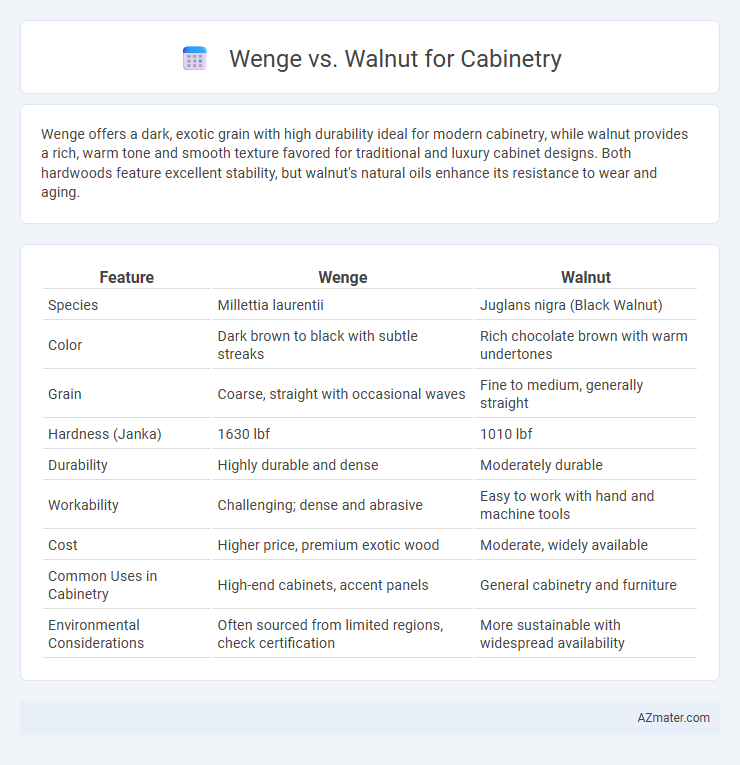Wenge offers a dark, exotic grain with high durability ideal for modern cabinetry, while walnut provides a rich, warm tone and smooth texture favored for traditional and luxury cabinet designs. Both hardwoods feature excellent stability, but walnut's natural oils enhance its resistance to wear and aging.
Table of Comparison
| Feature | Wenge | Walnut |
|---|---|---|
| Species | Millettia laurentii | Juglans nigra (Black Walnut) |
| Color | Dark brown to black with subtle streaks | Rich chocolate brown with warm undertones |
| Grain | Coarse, straight with occasional waves | Fine to medium, generally straight |
| Hardness (Janka) | 1630 lbf | 1010 lbf |
| Durability | Highly durable and dense | Moderately durable |
| Workability | Challenging; dense and abrasive | Easy to work with hand and machine tools |
| Cost | Higher price, premium exotic wood | Moderate, widely available |
| Common Uses in Cabinetry | High-end cabinets, accent panels | General cabinetry and furniture |
| Environmental Considerations | Often sourced from limited regions, check certification | More sustainable with widespread availability |
Introduction: Wenge vs Walnut for Cabinetry
Wenge and walnut are two popular hardwoods used in cabinetry, each offering distinct aesthetic and functional qualities. Wenge features a dark, rich brown color with deep grain patterns that provide a bold, modern look, while walnut is known for its warm, medium-brown tones and smooth texture that enhance traditional and contemporary designs. Both woods are durable and resistant to wear, making them ideal choices for high-quality cabinetry.
Origin and Botanical Background
Wenge wood originates primarily from Central Africa, especially the Democratic Republic of Congo, and belongs to the Millettia laurentii species known for its dark brown to blackish color with fine, closely spaced grains. Walnut, particularly English Walnut (Juglans regia) and Black Walnut (Juglans nigra), is native to regions across Europe, Asia, and North America, prized for its rich chocolate brown hues and distinct, swirling grain patterns. Both woods come from hardwood trees with dense, durable properties, but Wenge's tropical origin contrasts with Walnut's temperate climate growth, influencing their texture and workability in cabinetry.
Appearance: Color and Grain Differences
Wenge features a deep, rich chocolate brown color with subtle black streaks, offering a bold and exotic look, while Walnut displays a warm, medium to dark brown hue with occasional purple undertones, providing a classic and versatile appearance. The grain of Wenge is typically straight and fine, with a slightly coarse texture that enhances its dramatic effect, whereas Walnut has a smooth, straight to wavy grain that contributes to its elegant and refined look. These distinct color and grain variations make Wenge ideal for striking, contemporary cabinetry and Walnut perfect for traditional or transitional styles.
Durability and Hardness Comparison
Wenge wood has a Janka hardness rating of approximately 1630, making it notably harder and more resistant to dents and scratches than walnut, which typically has a Janka rating around 1010. The dense grain structure of Wenge contributes to superior durability, ideal for high-traffic cabinetry areas requiring long-lasting wear resistance. Walnut offers moderate hardness but excels in workability and finishes, making it suitable for cabinetry where aesthetic appeal and ease of customization are prioritized over extreme durability.
Workability and Machining
Wenge wood is dense and hard, making it more challenging to machine but resulting in a durable finish for cabinetry, though it may cause higher tool wear during workability. Walnut offers superior workability with its moderate hardness, allowing for easier cutting, shaping, and finishing while maintaining a smooth, refined surface. Both woods require sharp tools, but walnut is generally preferred for intricate designs due to its consistent grain and less abrasive nature.
Cost and Availability
Wenge is significantly rarer and more expensive than walnut, with prices often double due to its limited availability and sourcing from Central Africa. Walnut is widely available across North America and Europe, making it more cost-effective and accessible for cabinetry projects. Cost differences between wenge and walnut can affect project budgets, with walnut favored for affordable, high-quality cabinetry and wenge selected for premium, exotic designs.
Finishing Options
Wenge and walnut both offer rich, dark tones that enhance cabinetry, yet their finishing options differ significantly. Wenge's dense, fibrous texture pairs well with high-gloss and satin finishes, highlighting its natural grain and providing a sleek, modern aesthetic. Walnut, prized for its smooth, even grain, responds excellently to oil, wax, and matte finishes, allowing for a warm, classic look that deepens its chocolate-brown hues over time.
Environmental Impact and Sustainability
Wenge wood, sourced primarily from Central Africa, faces significant sustainability concerns due to overharvesting and habitat loss, leading to its classification as endangered by the IUCN. In contrast, walnut, especially American black walnut, benefits from more sustainable forestry practices and reforestation efforts, making it a more environmentally responsible choice. Choosing walnut cabinetry reduces the ecological footprint, as it is often harvested under regulated conditions that support forest regeneration and biodiversity preservation.
Best Applications for Each Wood
Wenge wood, known for its deep brown to black color and pronounced grain, is best suited for modern cabinetry designs requiring durability and a striking aesthetic, particularly in high-traffic kitchen environments. Walnut, featuring a rich, warm brown tone with subtle grain patterns, excels in traditional or rustic cabinetry, offering superior workability and a smooth finish ideal for custom furniture and detailed woodwork. Both woods provide longevity, but Wenge's hardness is preferable for heavily used surfaces, while Walnut's natural oils enhance cabinet longevity and resistance to wear in moderate-use areas.
Conclusion: Choosing Between Wenge and Walnut
Wenge offers a dark, bold grain with exceptional durability, making it ideal for modern, high-traffic cabinetry. Walnut provides a warm, rich tone with versatile grain patterns that complement traditional and contemporary designs. Select Wenge for striking, long-lasting cabinets or choose Walnut for timeless elegance and natural beauty.

Infographic: Wenge vs Walnut for Cabinetry
 azmater.com
azmater.com